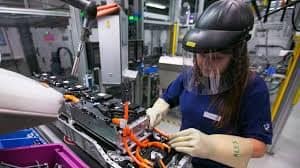Cobalt is a critical component in the cathodes for lithium-ion batteries because it provides the physical structure they need to operate properly. But most of the cobalt used today is mined in the Congo, often by children. Fossil fuel advocates have seized on that fact to attack electric cars, even as they continue to poison the atmosphere with the waste products of their fuels. As the demand for lithium-ion batteries has increased, so has the price of cobalt.
 Now researchers at the University of California – Berkeley have found a way to create disordered cathodes that use metals other than cobalt — such as manganese — in their cathodes. Not only are other metals far less expensive than cobalt, the new cathodes have 50% more capacity. “We’ve opened up a new chemical space for battery technology,” says Gerbrand Ceder, a professor in the Department of Materials Science and Engineering at Berkeley. “For the first time we have a really cheap element that can do a lot of electron exchange in batteries. To deal with the resource issue of cobalt, you have to go away from this layeredness in cathodes. Disordering cathodes has allowed us to play with a lot more of the periodic table.”
Now researchers at the University of California – Berkeley have found a way to create disordered cathodes that use metals other than cobalt — such as manganese — in their cathodes. Not only are other metals far less expensive than cobalt, the new cathodes have 50% more capacity. “We’ve opened up a new chemical space for battery technology,” says Gerbrand Ceder, a professor in the Department of Materials Science and Engineering at Berkeley. “For the first time we have a really cheap element that can do a lot of electron exchange in batteries. To deal with the resource issue of cobalt, you have to go away from this layeredness in cathodes. Disordering cathodes has allowed us to play with a lot more of the periodic table.”
Ceder is the senior author of a report published this month in the journal Nature. The research was conducted by scientists at UC Berkeley, Berkeley Lab, Argonne National Lab, MIT, and UC Santa Cruz.
Ceder and his colleagues have been working on disordered cathodes since 2014. Using a process called fluorine doping, the scientists incorporated a large amount of manganese in the cathode. Having more manganese ions with the proper charge allows the cathodes to hold more lithium ions, thus increasing the battery’s capacity, according to a report in Science Daily.
Cathode performance is measured in energy per unit weight, called watt-hours per kilogram. The disordered manganese cathodes approached 1,000 watt-hours per kilogram. Typical lithium-ion cathodes are in the range of 500-700 watt-hours per kilogram. “In the world of batteries, this is a huge improvement over conventional cathodes,” says co-author Jinhyuk Lee.
Now, of course, the hard work of turning the research into a commercially viable reality begins. But Ceder says whether or not manganese cathode technology actually makes it inside a battery is beside the point. The research has achieved something even more important by opening up new possibilities for cathode design. “You can pretty much use any element in the periodic table now because we’ve shown that cathodes don’t have to be layered,” Ceder says. “Suddenly, we have a lot more chemical freedom, and I think that’s where the real excitement is because now we can do exploration of new cathodes.”
For electric vehicle advocates, the news means the dream of batteries that cost less and are more environmentally friendly is getting closer to reality.






